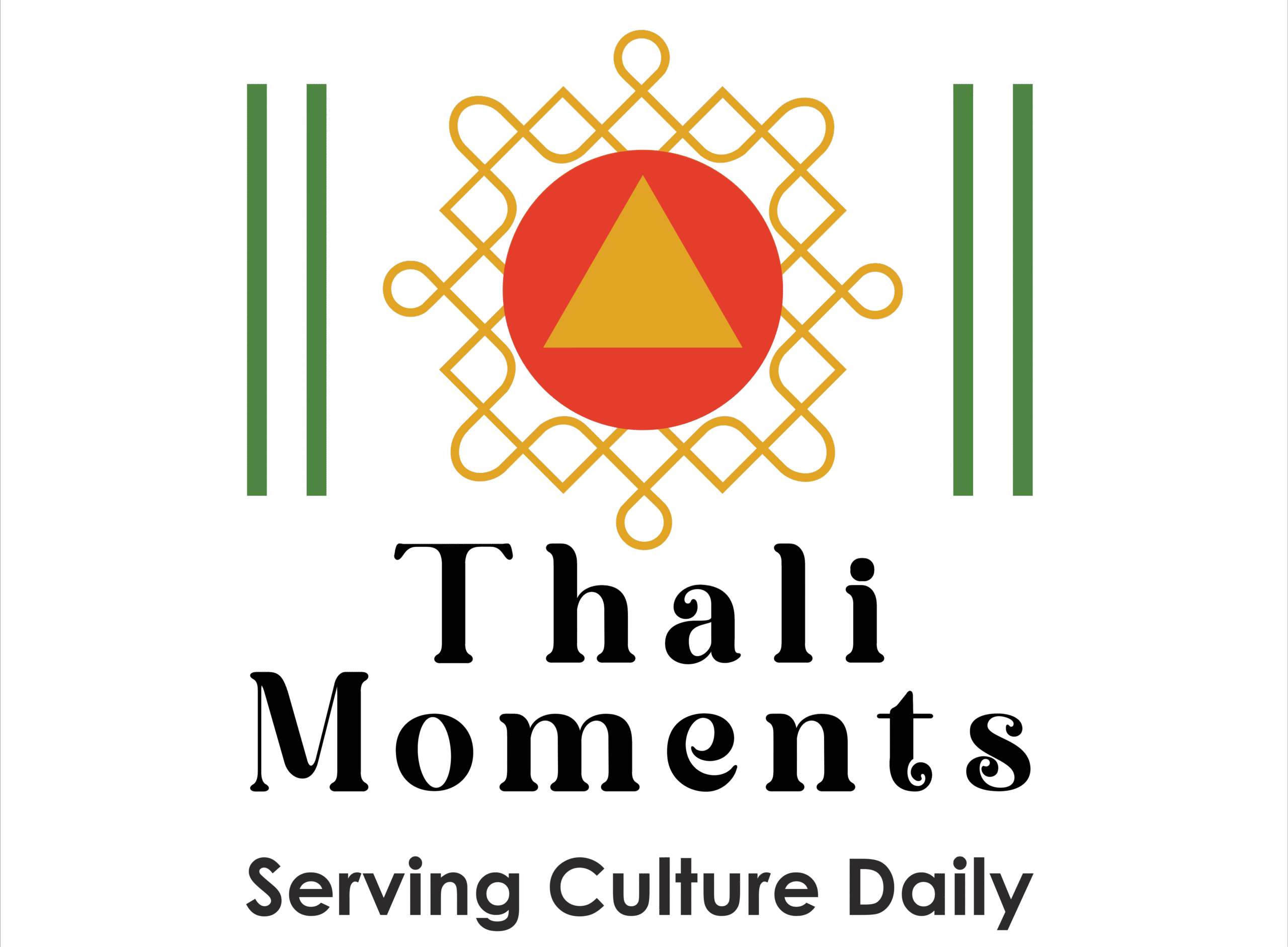From Summer Thalis to Winter Feasts: The Art of Seasonal Catering in Maharashtra
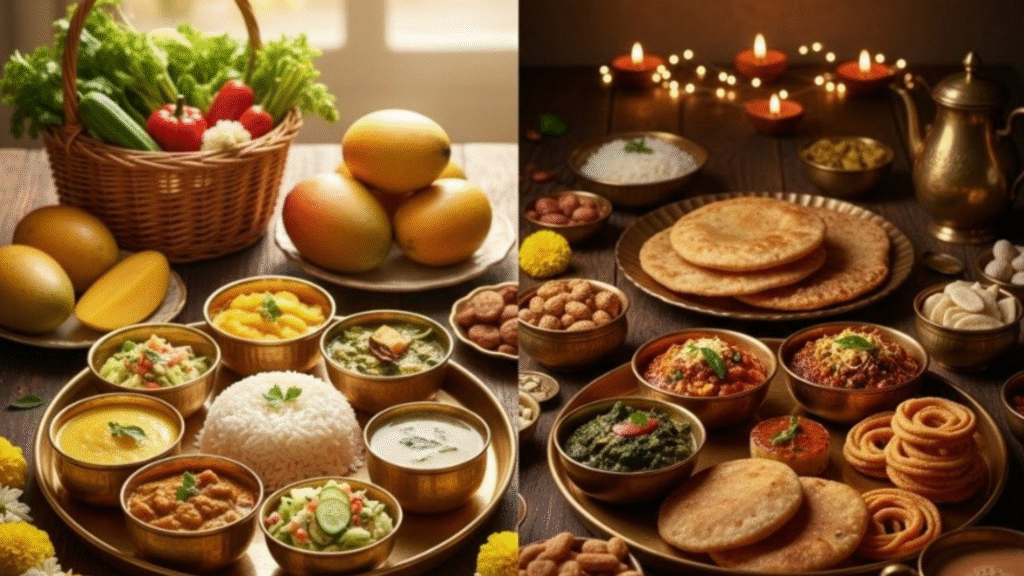
From Summer Thalis to Winter Feasts: The Art of Seasonal Catering in Maharashtra A well-planned menu can turn any event into an experience. But here’s a secret the best caterers in Pune already know, great food is about timing. The same dish that delights guests in December might feel heavy in May. That’s why seasonal catering matters. When menus change with the weather, food feels fresher, more flavorful, and in harmony with the moment. Whether it’s a wedding, corporate gathering, or festive event, choosing seasonal ingredients brings both taste and comfort to the table. Summer: Keep It Fresh, Light, and Cooling Summer in Pune can be harsh, and guests naturally crave light, refreshing meals. A smart summer catering menu focuses on cooling foods and hydrating flavors. Popular summer choices include: Aam panna, solkadhi, and buttermilk for natural refreshment. Varan-bhaat, koshimbir, and aamras for a traditional yet balanced thali. Fresh fruit platters and chilled desserts like mango shrikhand. These dishes not only cool the body but also keep guests energized, perfect for outdoor events and mid-day functions. Monsoon: Comfort Food for Cozy Gatherings Once the rains arrive, the appetite changes. Guests crave warmth, spice, and comfort. Monsoon menus are a chance for caterers to bring out nostalgic, home-style dishes. Some of the best catering services near you in Pune will recommend: Kanda bhaji, pakoras, and batata vada with hot chai or masala taak. Hearty curries like pithla-bhakri or usals made from sprouted pulses. Warm desserts like moong dal halwa or gulab jamun. The aroma of frying snacks and steaming curries creates the perfect backdrop for rainy-day celebrations. Winter: Rich, Festive, and Flavorful Winter is Pune’s favorite season for celebrations such as weddings, corporate events, and family gatherings fill the calendar. It’s also the season for indulgent food. Menus that shine in winter include: Puran poli, tilgul laddoos, and ghee-soaked sweets for festive warmth. Methi bhaji, harbhara usal, and lasun chutney for earthy flavor. Varan-bhaat, thecha, and bhakri for authentic Maharashtrian comfort. Cool weather calls for heartier spreads and deeper flavors, the kind that make guests linger over the meal a little longer. Why Seasonal Menus Just Work There’s a reason seasoned event caterers swear by seasonal planning: Better Taste – Fresh, local produce always beats stored or out-of-season ingredients. Healthier Meals – Seasonal foods naturally suit your body’s needs for the time of year. Cost Efficiency – Local sourcing keeps quality high and costs practical. Memorable Experiences – Guests remember when the food feels “just right.” No matter the occasion, food that matches the weather leaves a lasting impression and often, empty plates. Thali Moments: Rooted in Season, Crafted with Care At Thali Moments, we believe in letting the season guide the menu. Our catering in Pune celebrates Maharashtrian flavors at their freshest; from summer aamras and monsoon bhajis to winter puran polis. Whether you’re planning a wedding, festive event, or corporate gathering, our menus are designed around freshness, balance, and authenticity. Because great catering isn’t about repeating dishes; it’s about reading the season. In a nutshell Seasons change, and so should your menu. From cool drinks in summer to warm curries in winter, every event feels better when the food fits the weather. So, the next time you search for the best catering services near me or event caterers in Pune, remember, the perfect caterer isn’t just one who cooks well, but one who cooks with the season. Share On Recent Posts
Diwali on a Plate: How Food Lights Up Maharashtra’s Festival of Joy

Diwali on a Plate: How Food Lights Up Maharashtra’s Festival of Joy Long before the streets glow with fairy lights, Diwali begins quietly in the kitchen. The crackle of frying oil, the sweet aroma of roasting gram flour, the rustle of aluminium boxes being cleaned for faral storage. Every Maharashtrian home hums with a rhythm that feels both festive and familiar. For many of us, Diwali isn’t just seen or heard; it’s tasted. The Season of Faral and Family Days before Diwali, the house slowly transforms. Mothers and grandmothers tie up their hair, spread old newspapers across the floor, and begin the sacred ritual of faral. The kitchen fills with the sound of the chakli press creaking, children stealing bits of raw shankarpali dough, and the smell of ghee wrapping every corner of the home. Each item made carries its own story and purpose: Chakli – The golden spirals symbolized continuity, strength, and patience. Crisp and spiced, they were a reward for steady hands and careful timing; something every mother seemed to have mastered effortlessly. Karanji – The delicate half-moon pastries, stuffed with roasted coconut and cardamom, were made with a kind of devotion. Watching them puff into golden crescents was a small miracle in itself. Shev – Fried in batches, it added a salty balance to the sweetness around. And the first few strands were always handed over to whoever wandered near the stove. Laddoos – Round, soft, and sweet, they carried warmth in every bite. Whether besan, rava, or copra, each version had one rule, made by hand, never hurried. Anarse and Shankarpali – Reserved for patient hearts. Anarse with its jaggery sheen and shankarpali with its gentle crunch were the essence of a Maharashtrian Diwali with a simple, homemade joy. Even before the first diya was lit, the faral tins sat neatly on the table, covered with embroidered napkins which denotes a promise of celebration ready to unfold. Mornings of Ritual and Aroma Narak Chaturdashi mornings had a ritual order: oil massage, abhyangasnan, new clothes, and the first meal of the season. The fragrance of poha, batata bhaji, and hot jalebis mingled with that of freshly lit incense. The elders would insist on tasting every dish, smiling knowingly as the younger ones rushed through the rituals just to get to the food. That breakfast wasn’t just about eating; it was about welcoming light, starting the new year with warmth and togetherness. The Diwali Thali: A Feast of Balance By the afternoon of Laxmi Pujan, the dining table transformed into a full thali, a true portrait of harmony. Varan-bhaat with ghee for grounding. Batatyachi bhaji and koshimbir for balance. Puran poli, sweet and soft, for prosperity and grace. Papad, pickle, and taak for joy and ease. The plate mirrored life itself containing sweetness and spice, warmth and simplicity, all existing side by side. A Taste That Travels Through Time Ask anyone who grew up in Maharashtra what Diwali tastes like, and you’ll rarely hear just one answer. It’s the first bite of puran poli after prayers, the crunch of chakli shared with cousins, or the lingering smell of roasted besan on a cool October night. Even today, when life has grown faster and kitchens quieter, those flavors call us back. Maybe you don’t make faral from scratch anymore; maybe you order it, or pick it up on your way home. But the first bite still carries that memory. The laughter, the waiting, the togetherness. The Diwali Spirit at Thali Moments At Thali Moments, this nostalgia is what we try to preserve every Diwali. In our kitchen, the process still feels personal; spices roasted in small batches, sweets shaped by hand, and thalis assembled with the same care our grandmothers showed. Because for us, cooking isn’t just about food. It’s about memory. About honoring the light that shines from shared meals and familiar tastes. Diwali is more than rows of diyas and fireworks; it’s the quiet warmth of people coming together, sharing a thali, and remembering where joy truly lives. This season, may your plate hold more than just flavour, may it hold the sweetness of old memories, the spice of laughter, and the comfort of knowing that some traditions never fade, they simply find new homes. Happy Diwali! Share On Recent Posts
The Legacy of the Maharashtrian Thali: More than Just a Meal

The Legacy of the Maharashtrian Thali: More than Just a Meal In Maharashtra, food has always been about more than merely filling the stomach. It is about the stories passed down in kitchens, the warmth of hospitality, and the unspoken bond between those who share a plate. Nowhere is this more beautifully captured than in the Maharashtrian Thali. A Maharashtrian thali is, in its truest sense a canvas of traditions, festivals, and everyday joys. Each portion on the plate carries a tale of geography and culture. From the earthy comfort of varan-bhaat (simple dal-rice) to the celebratory sweetness of puran poli, the thali mirrors the life of the people of this land. Every bite is grounded yet full of flavour. A Plate of Seasons and Celebrations The thali changes as the seasons do. In summer, aamras makes its way to the plate, cooling the body and celebrating the arrival of mangoes. During Ganesh Chaturthi, modaks sweeten the offering. Weddings see lavish spreads with multiple vegetables, farsan, pickles, and sweets—an abundant display of joy and togetherness. Each festival brings with it a new chapter in the story of the thali. The Philosophy of Balance What makes the Maharashtrian thali truly special is the balance it maintains. Spices are not just about heat; they are about harmony. A spoonful of tangy solkadhi cools the tongue after a spicy bhaaji. A crisp papad adds crunch to the softness of rice and curry. Even nutrition plays its role naturally – grains, pulses, vegetables, dairy, and sweets come together to nourish both body and soul. A Gesture of Love and Respect In Maharashtrian homes, offering a thali is an act of care. Guests are not just served; they are honoured. The host ensures the plate is never empty, a sign that love is endless and hospitality knows no bounds. In villages, it is common for neighbours to send across portions of their festive meals-extending the thali beyond the home, weaving bonds within the community. Beyond Food—A Shared Identity For Maharashtrians living far from home, the thali is often their strongest connection back to their roots. A bite of Jhunka-Bhakri or the first taste of Shrikhand can instantly bring back memories of grandparents’ kitchens, family gatherings, and festivals filled with laughter. It is food as identity, a reminder that traditions live on as long as they are cooked, shared, and savoured. The Maharashtrian thali is not just about what is on the plate—it is about what it represents. It is heritage served in stainless steel, a culture carried forward one meal at a time, and a reminder that food, at its heart, is always about people. Share On Recent Posts
How to Plan a Stress-Free Catered Event in Pune
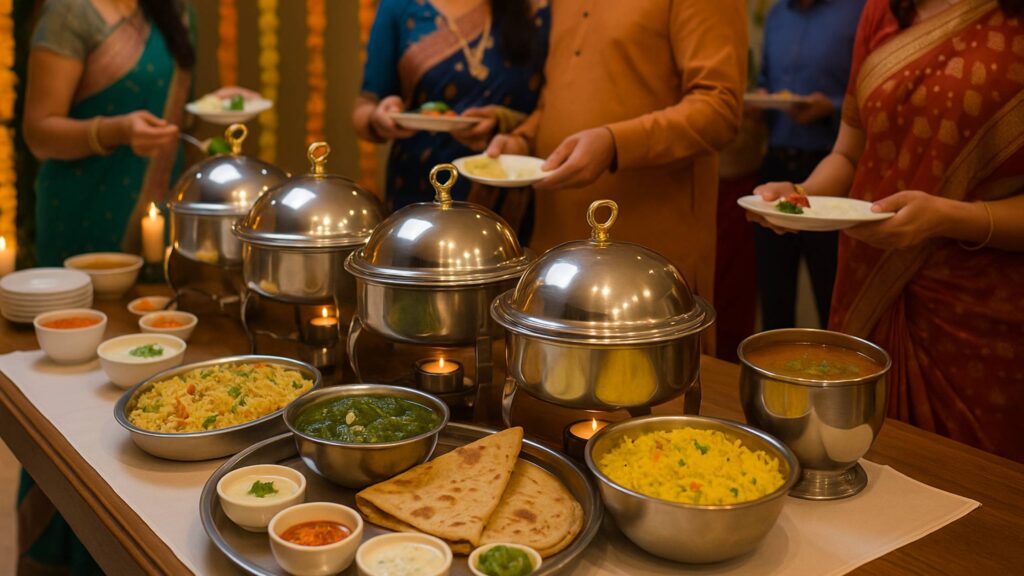
How to Plan a Stress-Free Catered Event in Pune We all host events for celebrating our small and large milestones. But planning an event should feel exciting, not overwhelming. Whether it’s a corporate gathering, a family function, or a wedding celebration, food often becomes the heart of the occasion. Guests remember how they were fed, and for hosts, the catering can either make the day smooth or stressful. The good news? With the right approach, hosting an event in Pune can be effortless and memorable. 1. Start with the Guest List Everything begins here. The number of guests determines the menu, portions, and style of catering. Are you inviting 50 people or 500? Corporate lunches often run smoother with compact menus, while weddings or milestone celebrations call for an elaborate spread. Having a clear headcount early helps your caterer plan without last-minute panic. 2. Choose the Right Catering Style In Pune, hosts typically choose between buffet, sit-down thalis, or a mix of live counters and plated meals. Buffet style works best for large gatherings where flexibility matters. Sit-down thali service offers a traditional and personal touch, especially at cultural or family functions. Hybrid setups with live counters (chaat, dosa, mocktails) add excitement to the event. The choice depends on your event’s mood – formal, festive, or casual. 3. Plan the Menu Around the Season A well-thought-out seasonal menu makes the event memorable and comfortable for guests. In Pune’s summers, cooling dishes like Aamras, Solkadhi, or buttermilk add freshness. Winters invite rich gravies, festive sweets, and hot snacks like Kothimbir Vadi or pakoras. Local caterers often suggest the best combinations because they know what works for both climate and culture. 4. Keep Logistics in Mind Food is not just about flavours, it’s also about flow. ‘How’ the food reaches the event matters. Venue layout, service counters, and staff coordination matter just as much. In smaller indoor venues, a thali service avoids crowding, while in open lawns, buffets and live counters keep people moving smoothly. Discussing these details early with your caterer saves stress on the event day. 5. Factor-in Dietary Preferences Every guest list today comes with variety and their own preferences—vegetarian, vegan, Jain, or even health-conscious eaters. A thoughtful menu that includes at least a few options for everyone ensures no guest feels left out. Pune, being a city with a cosmopolitan crowd, makes this especially important. 6. Work with Trusted Local Caterers Perhaps the biggest stress-buster is choosing the right partner. A reliable caterer doesn’t just provide food—they bring experience, planning, and solutions to unexpected hiccups. Local Pune caterers also bring in regional expertise, ensuring authentic Maharashtrian flavours alongside modern favourites. A Smooth Event, A Happy Host At the end of the day, catering is not just about serving meals, it’s about creating moments where the host can relax, and the guests feel cared for. With the right planning and the right team, your event in Pune can be remembered not for the stress of organizing, but for the joy of celebrating. Share On Recent Posts
How to Balance Nutrition in a Traditional Thali
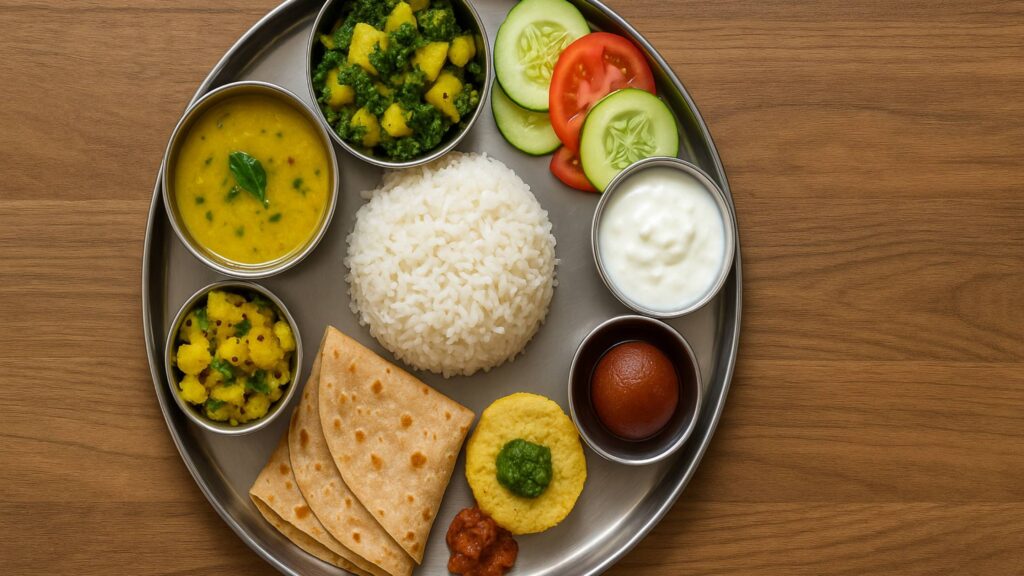
How to Balance Nutrition in a Traditional Thali A thali is more than just a feast for the senses. It’s a carefully balanced plate designed to nourish the body. While it may look like a spread of comfort food, the traditional Indian thali (and especially the Maharashtrian thali) hides centuries of wisdom about balance, variety, and health. The Science Behind the Thali Our ancestors didn’t need calorie charts or diet apps; They used simple logic. A thali typically includes: Grains: rice, bhakri, or chapati for energy. Pulses & legumes: varan, amti, usal for plant-based protein. Vegetables: seasonal sabzis that provide fiber, vitamins, and minerals. Dairy: dahi (curd) or buttermilk for probiotics and digestion. Pickles & chutneys: small portions that aid digestion and add flavor. Sweets: shrikhand, puran poli, or kheer to end on a satisfying note. Each element serves a purpose; not just in taste, but in keeping the body balanced. Portion is Key The beauty of a thali lies in its small, measured servings. Instead of one large dish, you get several small bowls. This naturally prevents overeating while still offering variety. The trick is to focus on balance: Half the plate with grains and vegetables. A quarter with protein-rich dals or pulses. A small portion for dairy and sweets. This way, the body gets both nutrition and satisfaction without excess. Seasonal Eating, the Natural Way Maharashtrian thalis change with the seasons, and that’s no accident. In summer, cooling dishes like aamras, taak (buttermilk), and solkadhi help beat the heat. Winter menus often include til-gul, hearty gravies, and fresh leafy greens that keep the body warm and nourished. Seasonal eating isn’t just tradition. It’s nature’s way of giving the body what it needs, when it needs it and our way of making sure we eat the right things in right time. Mindful Eating in a Modern World In today’s fast-paced lifestyle, thalis remind us of the importance of slowing down. Eating a variety of small dishes allows us to savour flavours, eat mindfully, and listen to our body’s hunger cues. Even for office-goers in Pune, a simple balanced thali can bring a touch of health and comfort into a busy day. A Thali as Everyday Nutrition While thalis shine during festivals and events, their real magic is in the everyday. A simple varan-bhaat with ghee, paired with a bhaaji and curd, is both humble and nutritionally complete. This daily rhythm of balanced meals is what has kept generations healthy and grounded. In the end, balancing nutrition in a thali is less about strict rules and more about respecting tradition. It’s about recognizing that health, taste, and culture can live together on a single plate. And that balance is what makes the thali timeless. Share On Recent Posts
A Day in the Life of Our Kitchen: From Prep to Plating
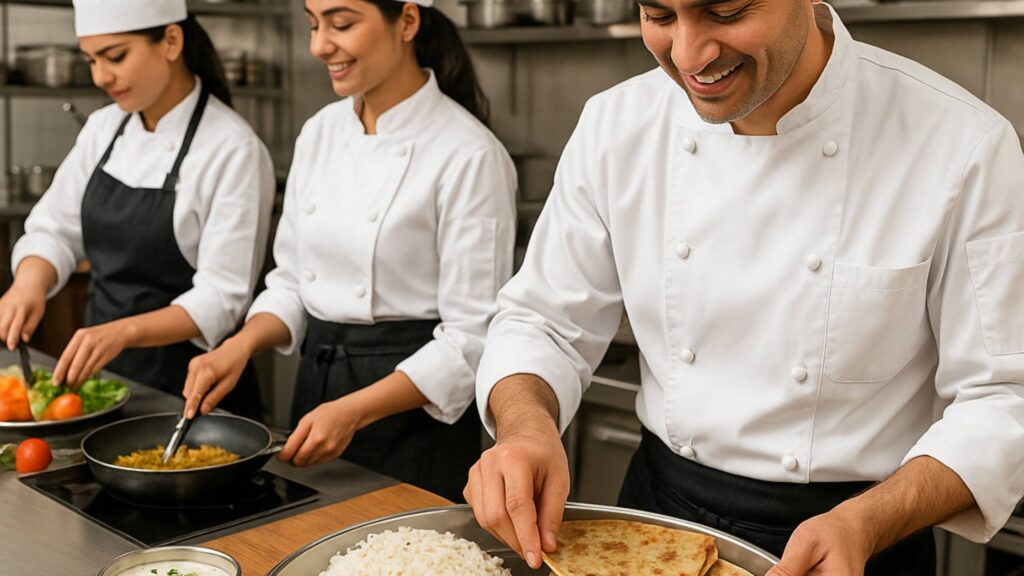
A Day in the Life of Our Kitchen: From Prep to Plating Behind every perfectly served thali lies a rhythm of work, care, and coordination that begins long before the guests arrive. At Thali Moments, our kitchen is more than just a space for cooking; it is where traditions meet teamwork, and where every event begins its journey. The Early Start Our day begins much before the city fully wakes. Fresh vegetables from Pune’s mandis arrive at dawn, brimming with colour and freshness. The team inspects every batch; for Marathi people, freshness is non-negotiable. From leafy greens for Pithla-Bhakri in winters to ripe mangoes for Aamras during the summers, sourcing sets the tone for the rest of the day. The Prep Rituals Once ingredients are sorted, the kitchen comes alive with chopping, grinding, and stirring. Spices are roasted and hand-ground, chutneys are freshly blended, and doughs are kneaded for Bhakris and Puran polis. There’s an old-world rhythm to this stage: “Recipes may be rooted in tradition, but they demand precision and consistency.” Cooking with Purpose By mid-morning, the bigger pots and pans take their place on the flames. Dals simmer, various Bhaajis take shape, and curries bubble to life. Every cook in our kitchen carries their speciality. One focuses on gravies, another on sweets, and someone else on finishing touches like tempering. It’s a team effort where timing matters as much as taste. The Quiet Checks Before the food ever reaches the guests, it passes through quiet checks. The head chef tastes every dish, adjusting spices, salt, or sweetness until it feels just right. It’s not about recipes alone, but about instinct. Knowing when the Amti has enough tang or if the Shrikhand feels too thick comes with experience and instinct. These small refinements are what make the meal memorable. From Kitchen to Plate Closer to service time, the kitchen shifts gears. Thalis are laid out in perfect order—Rice, Dals, Bhajis, Chutneys, Papads, pickles, and sweets all finding their place. At events, the team works in sync, ensuring no plate leaves half-filled and every guest feels cared for. Whether it’s a buffet line or a sit-down thali service, presentation is given the same respect as taste. More Than Just Food For us, it’s not only about feeding people—it’s about carrying forward the pride of Maharashtrian hospitality. Each meal is an offering of culture, prepared with the belief that food should bring joy, comfort, and connection. When a guest leaves an event remembering the taste of puran poli or the spicy coolness of Solkadhi, we know the kitchen has done its job well. What begins as a morning of chopping and simmering ends as an experience shared across plates and conversations. Share On Recent Posts
